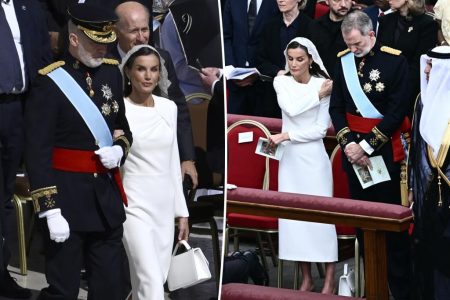The past decade has seen a significant rise in the prominence of menswear in the fashion industry, with menswear now being considered a scene-stealer at ready-to-wear shows. The upcoming Costume Institute exhibition at the Met Gala will focus on menswear for the first time since 2003, highlighting the industry’s importance as a fashion trendsetter. The suit, a classic symbol of maleness, has taken center stage at recent women’s shows, with designers putting their own unique spins on the traditional garment. Whether oversized, slim and cropped, or paired with unexpected pieces like tiny shorts or flowy skirts, the suit remains a staple in menswear.
While there was a sense of softness in the spring women’s collections, menswear looks were characterized by strength and sex appeal. Hot men’s fashion trends included trim double-breasted navy jackets and thigh-baring running shorts, inspired by Gladiator II star Paul Mescal and the masculine ideal set by the original film in 2000. Designers, many of whom are gay men, are redefining the masculine ideal by focusing on the thigh, hip, and lower back as erogenous zones. Unique and daring designs, such as cropped jackets, low-slung trousers, and low-rise jeans, add a provocative edge to men’s fashion, enticing onlookers with unexpected flashes of skin. The culture is now embracing a grown-up version of the boy-next-door ideal, represented by celebrities like Mescal, Harry Styles, and Jacob Elordi.
The focus on menswear in the fashion industry reflects its role as an industry barometer, measuring the speed and direction of fashion trends. The suit, a timeless symbol of masculinity, continues to be a versatile and essential piece in men’s wardrobes, offering designers endless opportunities for reinterpretation and reinvention. Designers are pushing boundaries and challenging conventional notions of masculinity through their creative and daring designs, incorporating unexpected elements like thigh-baring shorts and low-rise jeans to add a contemporary edge to traditional menswear. By redefining erogenous zones and playing with notions of sex appeal, designers are creating bold and provocative looks that are resonating with consumers and reshaping the image of masculinity in fashion.
The upcoming Costume Institute exhibition and Met Gala focusing on menswear signals a shift in the fashion industry towards recognizing the significance of menswear as a driving force in shaping trends and defining fashion culture. The inclusion of menswear in high-profile events like the Met Gala highlights its increasing importance and influence in the fashion world, giving male fashion designers and consumers a platform to showcase and celebrate their unique perspectives and contributions to the industry. By spotlighting menswear in a major fashion exhibition, the industry is acknowledging and affirming the creativity and innovation that male designers bring to the table, paving the way for greater diversity and inclusivity in the fashion landscape.
As men’s fashion continues to evolve and make a statement on the runway, designers are exploring new ways to challenge traditional notions of masculinity and redefine what it means to be a man in today’s society. From unique silhouettes and unexpected pairings to daring cuts and risqué designs, menswear is pushing boundaries and breaking stereotypes to create a more inclusive and diverse fashion landscape. By embracing and celebrating the diversity of male identities and styles, designers are opening up new possibilities and opportunities for self-expression and creativity in men’s fashion, paving the way for a more inclusive and accepting industry that welcomes and celebrates the unique perspectives and contributions of all individuals.















